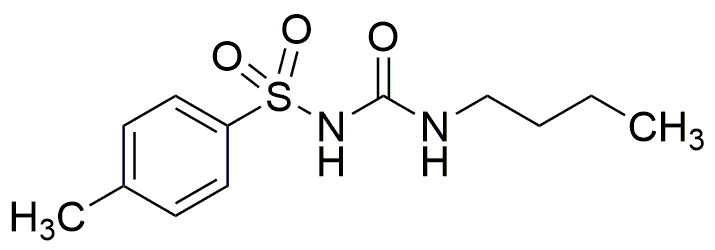Tolbutamide is widely utilized in research focused on:
- Diabetes Management: This compound is primarily used as an oral hypoglycemic agent to help control blood sugar levels in patients with type 2 diabetes. It stimulates insulin release from the pancreas, making it a vital medication in diabetes care.
- Pharmaceutical Research: Researchers often study tolbutamide to understand its mechanisms and effects on glucose metabolism, which can lead to the development of new diabetes treatments or improved formulations.
- Drug Interaction Studies: Tolbutamide serves as a model compound in pharmacokinetic studies to investigate how different drugs interact with metabolic pathways, providing insights that can enhance patient safety and efficacy of treatments.
- Clinical Trials: It is frequently included in clinical trials aimed at evaluating new diabetes therapies, helping to establish benchmarks for efficacy and safety against established treatments.
- Education and Training: In academic settings, tolbutamide is used in pharmacology and medicinal chemistry courses to teach students about sulfonylureas and their role in managing diabetes, enriching their understanding of drug mechanisms.
General Information
Properties
Safety and Regulations
Applications
Tolbutamide is widely utilized in research focused on:
- Diabetes Management: This compound is primarily used as an oral hypoglycemic agent to help control blood sugar levels in patients with type 2 diabetes. It stimulates insulin release from the pancreas, making it a vital medication in diabetes care.
- Pharmaceutical Research: Researchers often study tolbutamide to understand its mechanisms and effects on glucose metabolism, which can lead to the development of new diabetes treatments or improved formulations.
- Drug Interaction Studies: Tolbutamide serves as a model compound in pharmacokinetic studies to investigate how different drugs interact with metabolic pathways, providing insights that can enhance patient safety and efficacy of treatments.
- Clinical Trials: It is frequently included in clinical trials aimed at evaluating new diabetes therapies, helping to establish benchmarks for efficacy and safety against established treatments.
- Education and Training: In academic settings, tolbutamide is used in pharmacology and medicinal chemistry courses to teach students about sulfonylureas and their role in managing diabetes, enriching their understanding of drug mechanisms.
Documents
Safety Data Sheets (SDS)
The SDS provides comprehensive safety information on handling, storage, and disposal of the product.
Product Specification (PS)
The PS provides a comprehensive breakdown of the product’s properties, including chemical composition, physical state, purity, and storage requirements. It also details acceptable quality ranges and the product's intended applications.
Certificates of Analysis (COA)
Search for Certificates of Analysis (COA) by entering the products Lot Number. Lot and Batch Numbers can be found on a product’s label following the words ‘Lot’ or ‘Batch’.
*Catalog Number
*Lot Number
Certificates Of Origin (COO)
This COO confirms the country where the product was manufactured, and also details the materials and components used in it and whether it is derived from natural, synthetic, or other specific sources. This certificate may be required for customs, trade, and regulatory compliance.
*Catalog Number
*Lot Number
Safety Data Sheets (SDS)
The SDS provides comprehensive safety information on handling, storage, and disposal of the product.
DownloadProduct Specification (PS)
The PS provides a comprehensive breakdown of the product’s properties, including chemical composition, physical state, purity, and storage requirements. It also details acceptable quality ranges and the product's intended applications.
DownloadCertificates of Analysis (COA)
Search for Certificates of Analysis (COA) by entering the products Lot Number. Lot and Batch Numbers can be found on a product’s label following the words ‘Lot’ or ‘Batch’.
*Catalog Number
*Lot Number
Certificates Of Origin (COO)
This COO confirms the country where the product was manufactured, and also details the materials and components used in it and whether it is derived from natural, synthetic, or other specific sources. This certificate may be required for customs, trade, and regulatory compliance.

